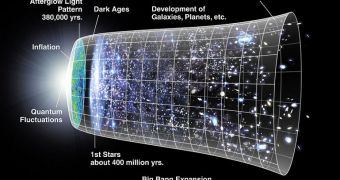Astronomers have recently made an incredible discovery, when they managed to discover a very old star in a nearby dwarf galaxy called Sculptor. The object is located about 290,000 light-years away from Earth, and its presence there holds several important implications for science.
One of them is that the Milky Way definitely cannibalized on surrounding dwarf galaxies to get to the size it has today. The other is that the chemical composition of the newly-found star indicates that it is tremendously old, and that it most likely belongs to the second generation of stars ever produced.
The object is tremendously faint, with a magnitude of only 18. Designated S1020549, the star was investigated in depth using the Las Campanas, Chile-based Magellan-Clay telescope, which belongs to the Carnegie Institution for Science (CIS).
Experts were looking to determine the abundance of metals inside this particular star. This is very important because the environment of the early Universe was tremendously metal-poor. Not enough stars had exploded yet to allow for heavier chemicals to form.
S1020549 was found to have a metal concentration about 6,000 times lower than the Sun's. This was also much lower than any other similar measurement conducted in a dwarf galaxy, experts say.
“This star likely is almost as old as the Universe itself,” explains Harvard-Smithsonian Center for Astrophysics (CfA) astronomer Anna Frebel. The new discovery also provides experts with insights about how our galaxy formed, and the stages it went through to get to this point.
“The original idea that the halo of the Milky Way was formed by destroying a lot of dwarf galaxies does indeed appear to be correct,” explains CIS expert and study co-author Josh Simon.
“If you watched a time-lapse movie of our galaxy, you would see a swarm of dwarf galaxies buzzing around it like bees around a beehive. Over time, those galaxies smashed together and mingled their stars to make one large galaxy – the Milky Way,” Frebel explains.
“We have, in effect, found a flaw in the forensic methods used until now. Our improved approach allows us to uncover the primitive stars hidden among all the other, more common stars,” adds the lead author of the new study, expert Else Starkenburg.
“Not only has our work revealed some of the very interesting, first stars in these galaxies, but it also provides a new, powerful technique to uncover more such stars. From now on there is no place left to hide!” the investigator says, quoted by Daily Galaxy.

 14 DAY TRIAL //
14 DAY TRIAL //